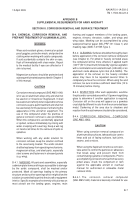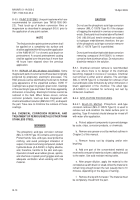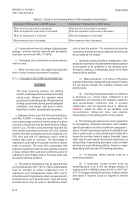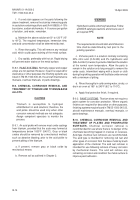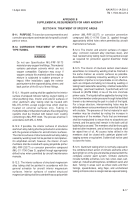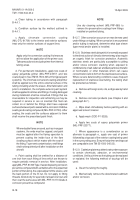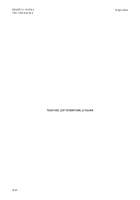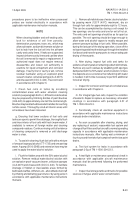TM-1-1500-344-23-2 - Page 219 of 240
B-17
NAVAIR 01-1A-509-2
TM 1-1500-344-23-2
15 April 2009
B-11. PURPOSE
. This section covers preventive and
corrective procedures and materials for specific aircraft
parts or areas.
B-12. CORROSION TREATMENT OF SPECIFIC
TYPE TUBING.
WARNING
Do not use Specification MIL-PRF-16173
material on any oxygen line fittings. This material
contains petroleum solvents which are not
oxygen compatible. Explosion may occur if
oxygen contacts this material and the resulting
mixture is subjected to sudden pressure or
impact. After installation, apply the exterior
paint system to the exposed tubing, sleeve, and
back portion of the B nut of these fittings.
B-12.1. No paint coating shall be applied to the interior
surface of airspeed indicator tubing, oxygen tubing, or
other plumbing lines. Interior and exterior surfaces of
other aluminum alloy tubing shall be treated with
MIL-DTL-81706, except oxygen lines which shall be
treated on external surfaces only. Tubing in
methylbromide or trifluorobromoethane fire extinguishing
systems shall be finished with baked resin coating
conforming to MIL-PRF-3043. The process shall be in
accordance with MIL-C-5056.
B-12.2. If possible, the interior surfaces of structural
aluminum alloy tubing shall be protected in accordance
with the general schedule for aircraft interior surfaces.
The interior surfaces of structural aluminum alloy tubing
sealed by welding need not be painted on land planes.
On amphibian aircraft, however, the interior of such
members shall be coated with epoxy polyamide primer
(MIL-PRF-23377) or corrosion preventive compound
(MIL-C-11796 Class 3), applied through appropriately
drilled holes when permitted by aircraft maintenance
manuals.
B-12.3. The interior surfaces of structural magnesium
alloy tubing shall be painted in accordance with the
general schedule for aircraft interior magnesium
surfaces. Interior surfaces of sealed structural
magnesium tubing shall be coated with epoxy polyamide
primer (MIL-PRF-23377) or corrosion preventive
compound (MIL-C-11796 Class 3), applied through
appropriately drilled holes when permitted by aircraft
maintenance manuals.
B-12.4. The interior and exterior surfaces of copper
alloy, corrosion resistant alloy (stainless steel), and
heat resistant alloy tubing need not be painted except
as required for protection against dissimilar metal
contact.
B-12.5. The interior of structural carbon steel tubular
assemblies not closed by welding shall be finished in
the same manner as exterior surfaces as possible.
Assemblies completely closed by welding or to which
application of primer is not practicable or not effective,
such as crimped-end tubing not closed by welding or
tubing heat treated after assembly, shall be treated after
assembly, (and heat treatment, if performed) with hot
linseed oil (ASTM D260) in lieu of the zinc chromate
primer coats. The liquid shall be applied by forcing it into
the hollow member under pressure through holes drilled
therein or by immersing the part in a bath of the liquid.
For a large structure, interconnecting holes may be
drilled between various members in order that the liquid
will circulate. The presence of the hot material in each
member may be checked by noting the increase in
temperature of the member. Parts that are immersed
shall be manipulated to ensure that no airpockets are
formed, and the parts shall remain in the bath until all
bubbling has ceased. The members shall be thoroughly
drained after treatment, and all exterior surfaces shall
be wiped free of oil. All access holes drilled in the
members shall be closed with cadmium plated self-
tapping screws or equivalent. Solder shall not be used
to close the holes.
B-12.6. Aluminum tubing which is normally exposed to
the combined direct action of climatic elements either
during flight or on the ground shall be protected with the
complete exterior paint system. Climatic elements
include humidity extremes, rain, hail, snow, sleet, salt-
laden air, industrial atmospheres, windblown sand, and
dust. Tubing in areas such as wheel wells and their
fairings, speed-brakes, wing flaps, and unsheltered
tubing at missile sites is categorized as exposed tubing.
APPENDIX B
SUPPLEMENTAL REQUIREMENTS FOR ARMY AIRCRAFT
SECTION IV. TREATMENT OF SPECIFIC AREAS
Back to Top

